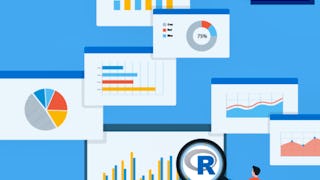In this course, you will learn the Grammar of Graphics, a system for describing and building graphs, and how the ggplot2 data visualization package for R applies this concept to basic bar charts, histograms, pie charts, scatter plots, line plots, and box plots. You will also learn how to further customize your charts and plots using themes and other techniques. You will then learn how to use another data visualization package for R called Leaflet to create map plots, a unique way to plot data based on geolocation data. Finally, you will be introduced to creating interactive dashboards using the R Shiny package. You will learn how to create and customize Shiny apps, alter the appearance of the apps by adding HTML and image components, and deploy your interactive data apps on the web.

Enjoy unlimited growth with a year of Coursera Plus for $199 (regularly $399). Save now.

Data Visualization with R
This course is part of multiple programs.



Instructors: Yiwen Li
30,470 already enrolled
Included with
(266 reviews)
What you'll learn
Create bar charts, histograms, pie charts, scatter plots, line graphs, box plots, and maps using R and related packages.
Design customized charts and plots using annotations, axis titles, text labels, themes, and faceting.
Create maps using the Leaflet package for R.
Create interactive dashboards using the Shiny package for R.
Skills you'll gain
Details to know

Add to your LinkedIn profile
See how employees at top companies are mastering in-demand skills

Build your subject-matter expertise
- Learn new concepts from industry experts
- Gain a foundational understanding of a subject or tool
- Develop job-relevant skills with hands-on projects
- Earn a shareable career certificate

There are 4 modules in this course
Data without a way to convey the story behind it to yourself or others is just numbers on a page. You can observe and tell the story of your data in a more impactful way through visualization. In this module, you will learn the basics of data visualization using R, including the fundamental components that are shared by all charts and plots, and how to bring those components to life using the ggplot2 package for R. You will also learn how to create three common chart types, including bar, histogram, and pie charts, from the qualitative and quantitative data.
What's included
5 videos3 readings4 assignments1 app item1 plugin
In this module, you will take your data visualization skills to the next level! You will learn how to create three plot types, including scatter plots, line, plots, and box plots, using the ggplot2 library and then customize the visualizations using annotations and customized axis titles and text labels. You will also learn about faceting, a way to visualize each level of a discrete or categorical variable, and different ways to work with themes. Finally, you will learn about a unique chart type called a map that you can create using geolocation data and the Leaflet library.
What's included
6 videos2 readings4 assignments2 app items3 plugins
Your data tells a story. You have built the charts and plots that show important relationships between variables, identify outliers and anomalies, and see the trends that can help you predict what the future might bring. Now you want to put these insightful data visualizations at the fingertips of your stakeholders and make it easy to interact with and explore the data. You need a dashboard! In this module, you will learn why dashboards are important and then build interactive dashboards using the Shiny package for R. You will learn how Shiny dashboards are structured into user interface and server components and then build out these components and develop the logic to make them work together. You will also learn how to deploy your dashboards and provide a way to generate informative reports with R Markdown.
What's included
6 videos2 readings4 assignments2 ungraded labs5 plugins
What's included
3 readings1 assignment1 peer review1 ungraded lab1 plugin
Earn a career certificate
Add this credential to your LinkedIn profile, resume, or CV. Share it on social media and in your performance review.
Explore more from Data Analysis
 Status: Free Trial
Status: Free TrialJohns Hopkins University
 Status: Free Trial
Status: Free TrialJohns Hopkins University
 Status: Free Trial
Status: Free TrialJohns Hopkins University
 Status: Free Trial
Status: Free TrialJohns Hopkins University
Why people choose Coursera for their career




Learner reviews
266 reviews
- 5 stars
76.69%
- 4 stars
16.16%
- 3 stars
3.38%
- 2 stars
1.50%
- 1 star
2.25%
Showing 3 of 266
Reviewed on Jul 9, 2022
The course was good and the videos explained the topic very well and the content was indeed very nice..thanks for providing such a good course
Reviewed on Aug 8, 2024
Very good explanation in theory as well as practice
Reviewed on May 13, 2023
great i learned alot and practice many things in a different way,thanks coursera
Frequently asked questions
To access the course materials, assignments and to earn a Certificate, you will need to purchase the Certificate experience when you enroll in a course. You can try a Free Trial instead, or apply for Financial Aid. The course may offer 'Full Course, No Certificate' instead. This option lets you see all course materials, submit required assessments, and get a final grade. This also means that you will not be able to purchase a Certificate experience.
When you enroll in the course, you get access to all of the courses in the Certificate, and you earn a certificate when you complete the work. Your electronic Certificate will be added to your Accomplishments page - from there, you can print your Certificate or add it to your LinkedIn profile.
More questions
Financial aid available,
¹ Some assignments in this course are AI-graded. For these assignments, your data will be used in accordance with Coursera's Privacy Notice.






